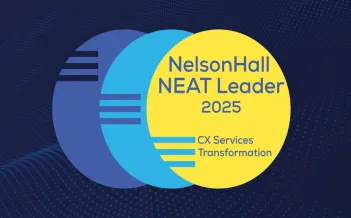In the last twenty years – since email became “a thing” – the rate at which technology has transformed the way we do business is staggering. I’ve seen these changes firsthand. When I first started working, there were no laptops or mobile phones in the office. If you wanted to speak to a colleague or a client, you had to go and see them or arrange a time to speak to them on the phone.
No matter the industry, digital has become the go-to for organizations big and small, as they manage their day-to-day operations, sell to prospects and market themselves. This also means that business transformation today is synonymous with digital transformation. To successfully upgrade and evolve a business in the modern age, digital cannot be just an afterthought. Instead, digital should be put right at the heart of a business’ growth strategy.
A customer-shaped opportunity
The digital revolution has driven many of the advances we’ve made in business in recent years. One of the main areas that it has helped to grow and foster is the way brands engage with their customers.
Customer service used to be about the experiences brands gave consumers over the counter, or the tone they took in the letters they sent to them. This is not to say that brands did not execute customer service well twenty or thirty years ago – but this was customer service for a non-digital age. Back then, it was all about telling customers what they needed to know in a timely and transparent fashion, and intelligently broadcasting the messages that a business wanted its prospective and existing customers to hear.
Now, a
digital approach to customer experience sees brands focusing on engaging and opening up a dialogue with their customers. The “always-on” nature of digitally-led customer service, bought to life through social media, 24/7 web chat and information that can be accessed online at any time of the day or night means that the power to decide how and when they have a conversation with a brand is now firmly in the hands of the consumer.
One example of this is the work we do with Sky, helping deliver a messenger style contact channel for customers to access support from Sky anytime and anywhere, through Facebook, SMS or app. The beauty of this solution is that decisions about a specific contact are entirely the customers’ – they not only have the ability to initiate contact but can also decide how and when to do it.
And it’s a setup that works. To date, we’ve worked with Sky to manage up to 10,000 contacts a day through the messenger service. For brands that are willing to invest in making the most of digital, it can be a real opportunity to create that much sought-after closer connection with their customers.
The role of social media and omnichannel communications
Today, if you want to know what consumers think of your brand, you can quickly and easily find this out via social media.
In a digital world, peer reviews, customer forums, Twitter and Facebook pages are some of the best ways of temperature checking customer sentiment towards an organization. Unbiased and often unfiltered, they can also have a huge impact on wider audiences – including other existing and prospective customers. In fact,
92% of consumers say they trust ‘earned media’, such as social media, above all other forms of marketing. At Firstsource we’ve even used the influence that social media can have on prospective and existing customers to manage customer forums – such as giffgaff’s member forums - to effectively address customer issues and help them reach the right solution quicker than ever.
The opportunity for brands to deliver great customer experience by harnessing the power of social media should not be underestimated. Social channels offer many advantages over traditional marketing, including cost and the ability to react in real-time. Managed well, social customer interactions can also showcase end-consumers as the biggest brand advocates.
Chatbots and advances in artificial intelligence have also made digital and self-serve communication channels popular options for brands looking to reduce costs and maintain consistency when they interact with customers. Great customer experience means offering more options – and when it comes to customer service, that equates to offering more channels for customers to connect with a brand. While traditional channels such as voice will always have a place in good customer communications, digitally-savvy consumers today also expect to be able to get in touch via digital means. To meet customer expectations, it’s vital that brands offer online options as part of their channel mix.
Embracing and investing in digital
As experts in
customer experience, the teams at Firstsource work with businesses who are all at different stages in their digital journey. And no matter how advanced the technology we employ, our message to them is always the same – to stay successful, businesses must stay ahead of the curve and avoid becoming complacent in their digital transformation.
By its very nature, digital transformation is always evolving, and it is crucial that organizations embrace changes and constantly look at ways to implement improvements to the digital solutions used by their business. In today’s marketplace, a failure to invest in digital will almost certainly lead to a fall in shareholder returns. In fact, one of the most important things that I tell my clients is that the cost of simply doing nothing will outweigh the cost of driving change. In my experience, it’s the companies that are willing to take risks and explore the unknown that reap rewards in the end. Enabling digital technology will not necessarily involve a massive overhaul of your core systems. But with the right design and blend of enablers, the outcome can be hugely positive and could truly transform your business.
This article was originally published at
economia










